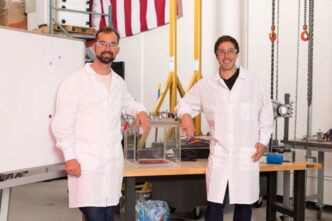When you think of aerial imaging, satellites, drones, and planes usually come to mind. But Near Space Labs is rewriting that playbook. Instead of traditional aircraft, the startup uses helium balloons to lift its custom-designed Swift robots high into the stratosphere. Floating with wind currents, these robots capture stunning high-resolution images before gliding safely back to earth. Thanks to growing demand, Near Space Labs has just secured $20 million to fuel its next phase of growth.
The latest Series B funding round was led by Bold Capital Partners, founded by Peter Diamandis of XPRIZE and Singularity University. Strategic investor USAA also participated, alongside Climate Capital, Gaingels, River Park Ventures, and returning backers like Crosslink Capital, Third Sphere, and Draper Associates. This round brings Near Space Labs’ total funding to over $40 million, following a $13 million Series A in 2021.
A Unique Path from the Skies to Stronger Ground
Near Space Labs was founded by three space and physics experts: CEO Rema Matevosyan, CTO Ignasi Lluch, and Chief Engineer Albert Caubet. Matevosyan, who grew up in a technical family in Armenia, first crossed paths with Lluch at the Skolkovo Institute of Science and Technology in Moscow—a venture once closely tied to MIT.
Their collaboration took root in 2017 when they joined Urban-X, a U.S.-based accelerator program. Although global events later disrupted their educational and accelerator programs—Skolkovo’s MIT ties were cut after Russia’s 2022 invasion of Ukraine, and BMW shut down Urban-X—Near Space Labs continued to rise.
Today, the company is headquartered in the U.S., with Matevosyan leading operations. Staying resilient in changing times, the startup remains committed to its mission of capturing a clearer view of the earth from the edge of space.
Expanding Coverage and Unlocking New Markets
Near Space Labs already counts major insurance companies among its biggest customers. Insurers use its imagery to assess damages after natural disasters like wildfires and hurricanes. With USAA also backing the company, it’s clear the insurance sector sees strong value in fast, detailed aerial imaging.
Currently, Near Space covers selected areas across the U.S. However, the company plans to scale aggressively. Because its Swift robots don’t require engines or pilots, they avoid the strict licensing that applies to traditional aircraft. Powered by balloons and the wind, they offer a low-cost, scalable solution. The company’s goal? To photograph areas covering 80% of the U.S. population twice a year, with sharp 7-centimeter resolution.
Matevosyan highlighted that capturing these images with drones would take nearly 800,000 drone-days, compared to just hours with Near Space’s technology. The company is also working on more customized coverage plans to meet specific customer needs.
Beyond insurance, agriculture is shaping up as a new frontier. Traditional drone surveys often fall short on large farms, capturing small sample areas that don’t fully reflect the health of crops. Satellites, meanwhile, can’t deliver high enough resolution affordably. Near Space Labs believes its stratospheric images can offer farmers more accurate, cost-effective insights at scale.
Interestingly, despite its strategic potential, Near Space has so far stayed away from military contracts. Matevosyan confirmed that while Swift aircraft could technically carry limited payloads and serve dual-use roles, the company remains focused solely on commercial markets. Whether that remains the case in today’s evolving geopolitical climate remains to be seen.
For now, investors are betting big. As Bold Capital’s Will Borthwick put it, “Low-cost aerial imagery is valuable not just for insurance. With AI depending on fresh, high-quality data, the timing for Near Space Labs couldn’t be better.”













